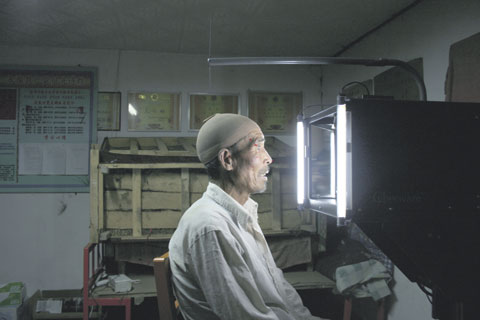Delta and Delft Integraal/Outlook often write about innovative ideas that offer big promises for the future. But what has happened to such ideas years later? What for instance has happened to Roger Ball’s ‘Size China’ project?
Consumer products like sunglasses and crash helmets, are currently being designed using data based on people residing in the western hemisphere. The drawback to this practice is that the resulting products are then less suitable for use by the Chinese.
But Associate Professor Roger Ball of Hong Kong Polytechnic University intends to change this with his project ‘Size China’. As part of his PhD research in 2006, Ball travelled across China with a 3D laser scanner measuring the skulls of some 2000 Chinese. This spring he will defend his thesis, ‘Size China, a 3D anthropometric survey of the Chinese head’.
“Doing the measurements was quit a feat,” recalls Ball’s co-supervisor, Dr Johan Molenbroek, of the Applied Ergonomics and Design department (faculty of Industrial Design), who helped Ball in China on several occasions. “The Chinese all have black hair, which reflects the laser beams, so we had to put nylon stockings around their heads.”
In an article in Delta in 2008, Ball said he was planning to scan the heads of people all around the world. What has become of that follow-up project, named ‘Size Global’? He is still looking for partners for that ambitious project, the designer replies by email. “And,” he adds, “to be honest another reason that project didn’t get off the ground yet is that TU Delft had kept me very busy trying to complete my PhD.”
The researcher is quick to add that his company has “some impressive sales to some of the top companies and brands in the world as they rush to develop products for China’s surging domestic market.”
Ball’s initial project in China was funded by the Chinese government. Such funding is difficult to find for the follow-up project, Ball explains: “I’ve found that countries are interested in their own individual population and not anyone else’s.”
Ball has been concentrating on scanning new areas of the Chinese body, including feet and hands. And he has developed new design tools: “We’re working on a CAD [design program, ed.] plug in for our Size China data. Once the datasets of other populations become available we can just plug and play with the data. I fully expect over the next ten years to develop the world’s first ‘Body Shape’ library for use in product design and development.”
Tijdens het Music Worlds Festival moeten verschillende muziekwerelden samenkomen. Hoe werkt dat?
“Het gaat dan vooral over de klassieke muziek van Krashna en de wereldmuziek. Daarmee bedoel ik volksmuziek uit allerlei delen van de wereld. Die wereldmuziek heeft een lange traditie en heeft altijd veel invloed gehad op andere stromingen. Zo zijn Afrikaanse ritmes terug te vinden in de jazz.”
Er zijn masterclasses en workshops voor leden van Krashna Musika en voor andere geïnteresseerden. Kunnen zij ieder willekeurig instrument bespelen?
“De masterclasses zijn voor klassieke muziek. Dan moet je dus wel een klassiek instrument bespelen. Maar de workshops gaan over wereldmuziek. Dan kun je best met je gitaar komen en mee jammen. Je kunt als zanger meedoen aan de Indonesische kecak, een stemtechniek. Ook de geschiedenis van de klassieke ballade komt langs. Er is een cursus djembé-percussie en is er aandacht voor Latijns-Amerikaanse muziek.”
Jullie hopen op interculturele uitwisseling met internationale studenten. Zitten daar veel muzikanten tussen?
“Uit het verleden weet ik dat veel internationale studenten bands vormen met mensen uit hun eigen gemeenschap. Ze spelen vaak traditionele muziek op hun eigen instrumenten. Zo is er in Delft bijvoorbeeld een grote Iraanse gemeenschap met een band die vaak optreedt. Er schijnt een Chinese groep te zijn en een aantal Afrikanen musiceert samen. Zo willen ze allemaal hun eigen achtergrond in stand houden. Voor ons is dat interessant, want al die ritmes hebben invloed op ons. Ik hoop dat ze allemaal komen op 1 mei.”
In mei is er voor het eerst een serie lunchconcerten op alle faculteiten. Wat krijgt het publiek daar te zien en te horen?
“Medewerkers en leden van Krashna die samen kamermuziek maken. Ook zo verbinden we via muziek mensen met elkaar. Op faculteiten zijn heel veel mensen die van muziek houden en praktiseren, merkte ik alleen al op mijn eigen afdeling bij EWI. Ik heb veel contacten bij Technische Natuurwetenschappen, waar al geregeld lunchconcerten zijn gehouden. Zo kreeg ik het idee om samen stukken in te studeren. Mensen die zich opgeven komen overal vandaan: uit de secretariaten, of de ondersteuning. Of het zijn hoogleraren. Iedereen kan straks op de eigen faculteit spelen, maximaal vijf minuten per persoon.”
Ben je zelf muzikaal actief op een van de activiteiten in mei?
“Ik ben pianist, dus breed inzetbaar. Ik ga mensen begeleiden als ze geen andere pianist kunnen vinden. Er staan op verschillende faculteiten piano’s en vleugels, bij EWI, TNW en Bouwkunde. Soms staan ze in een hoekje van een vergaderzaal te verpieteren, soms worden ze vaak gebruikt.”
Voor de kamermuziekconcerten op de faculteiten kunnen medewerkers zich nog opgeven.
www.krashna.nl



Comments are closed.